INTRODUCTION
Organizational behaviour (OB) is a process of studying ways in which people interact with each other in the organization. This is generally applied to increase the efficiency of the business. It can be applied to evaluate the management of the workers. It is a study of both members working and the organization as well. Organizational behaviour theories are used for human resource's purposes to maximize the output from individual group members. The main aim of organizational behaviour is to revitalize organizational theory and helps to develop a better conceptualization of the business. It is the basic concept of human resource (HR) and the organizational development.
This report will focus on the OB of company “A David & Co Limited” is a wholesaler of fruits and vegetables in United Kingdom. It has a wide range of seasonal and freshly produce vegetables and fruits. Along with this it also delivers dairy and bakery products like Milk, Cream, Yogurt, Mayonnaise, Butter, Egg, breads and buns, etc. A range of quality frozen bread, pastries and fruit is also available. This report will study influence of culture, politics and power on the behaviour of members working in the organization and evaluate theories of motivation and motivational techniques which can helps to enable the effective achievement of goals in the company.
LO 1
P1 Analysing the influence of culture, politics and power on the organizational behaviour:
Organizational culture is defined as shared assumptions, values, and beliefs, which helps to govern people on hoe to behave in organizations. These values have a strong influence on the people in the organization and contribute in the social and psychological environment of the organization. According to Charles Handy’s model, there are four different kinds of culture i.e. Power, Role, Task and Person, which is explained below,
- Power Culture: In power culture of the organization, it is defined as the power which is held by only few individuals who has a great influence throughout the organizational functions. They are the one who enjoys special privileges at their workplace. These are the most important people in the organization which takes the major decisions for the company. These individuals further delegate responsibilities to different employees working there. Employees are generally judged by what they have achieved rather than how they are doing their work. A power culture is usually a strong culture in the context of organizational behavior, so it has to be done very carefully (Dipboye, R.L. 2016).
- Task Culture: When there are teams to performs different functions or tasks in the organization, it is achieved by team culture. In such situations, individuals who have common interests and specializations come together to form a team. There are basically four to five members in a particular team. With appropriate skills, personalities and leadership, working in a team can be incredibly productive and creative for the organization. Every team member has to contribute equally in the work and accomplish their tasks in the most innovative and effective way.
- Role Culture: In this culture, every employee in the organization has given some roles and responsibilities according to their specialization, educational qualification and interest to get the best result from them. They are highly controlled and managed. Power in a role culture is determined by a person's position (role) in the organizational structure. In a culture, employees decide the best they can do and are willing to accept the challenge.
- Person Culture: In person culture, employees feels that they are more important and unique than their organization. In this, individuals are more concerned about their own self rather than the organization. Employees came to the office just for money and never get attached to it. They are loyal only towards their management and never decides in the favor of the organization (Gelfand, M.J. and et-al, 2017).
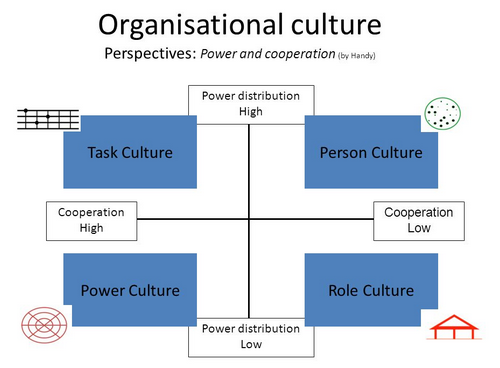
Illustration 1: Handy's 4 Organizational Culture
Source : Understanding Organizational Development and quality Culture. 2015
The importance of cultural awareness in the organization
Cultural Awareness is the foundation of communication between employees working in the company and it involves the ability of becoming aware of the cultural values, beliefs and perceptions. It helps to have some perspective and understanding of the organization's working. Understanding cultures will help the organization to overcome and prevent racial and ethnic divisions which can arise in the work place. Hofstede's cultural dimensions theory is a tool which is used to evaluate the cross-cultural communication of the employees in the organization. This model will help to understand the cultural difference awareness among people. This tool can be used to give an overview and an approximate understanding of other cultures, what to expect from them and how to behave towards groups from other countries, etc (Miner, J.B. 2015).
The Impact of Power and Politics in Organizational Behaviour
In any business or organization, power and politics plays an important role in making decisions for the employees as well as of the company. The impact of power depends on whether the employees use it as a positive or negative to influence others in the workplace. Whereas politics can directly influence the power and determines whether the overall culture of the workplace is productive or not. Positive power in an organization gives their employees the power to make their own decisions, rewarding them for their strong performance and appointing employees who perform strongly to supervise other employees in the organization . It helps to build confidence in them and motivates them to work hard. To increase productivity, they must develop a political culture to be easy for their employees to understand. Establishing a clear policies and commands will make it easier for them to spend more time on producing quality work for the organization (Greenberg, J. 2014).
LO 2
P2 Evaluating Theories of Motivation and Motivational Techniques
Motivation is the 'characteristic' which helps to achieve desired goal. It is very important for the organization to have employees which are motivated and dedicated towards their work. There are two types of motivation, i.e. Extrinsic and intrinsic motivation. It is very important to understand the employee's nature and what type of motivation should be given to them in order to work effectively in the organization. Such an understanding will enable them to better categorize the team members and apply the appropriate type of motivation.
- Extrinsic Motivation: When employee's motivational strength is coming from outside, it is known as Extrinsic motivation. The most well-known and debated motivation is the money. It contributes a lot to encourage employees to work more. These occur to perform work or engage in an activity to earn a reward from the organization. Various factors which helps in extrinsic motivations are, employee of the month award, benefit package, bonuses, organized activities, etc (D'Souza, J. and Gurin, M. 2016).
- Intrinsic motivation: When employee's motivational strength is coming from himself is known as Intrinsic Motivation. From this, employees has a desire to perform different tasks in accordance with his belief system or fulfills a desire. Some factors which can help to encourage this motivation, are, curiosity, acceptance, social interactions with people, etc.
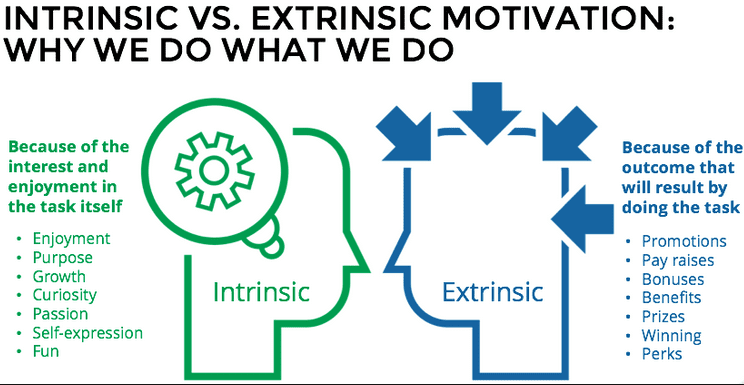
Illustration 2: Intrinsic and Extrinsic Motivation
Source : The power of intrinsic motivation. 2017
MOTIVATIONAL CONTENT THEORIES
Content theories are also known as Needs Theories, as they are associated with a view that concentrates on determining 'what' motivates the employees. In other words, they try to identify what are their 'needs' and relate motivation to fulfill these needs. There are various content theories known to us, for example,
- Maslow's Hierarchy of Needs: This is the most widely known theory of motivation. He proposed that motivation is the result of a person's attempt at fulfilling five basic needs, which is, physiological, safety, social, esteem and self-actualization. These needs can create an internal pressure on the person's mind which can influence its behavior. There are opportunities which helps to motivate employees through management style, for examples,
- Physiological Needs: These are the most important needs which a person sustains to life, fort example, air, water, food and sleep. If these are not satisfied properly than their motivational level will decrease with time. Organization can provide lunch breaks, rest breaks, and wages that are sufficient to purchase their essentials of life.
- Safety Needs: These needs has to be fulfilled by the organization by giving medical insurance to their employees, job security and financial stability, etc. If a person will feel safe, them they will give more attention towards their work. Organization should provide a safe environment to work.
- Social Needs: Social needs are those which is related with the interaction with other people working in the organization. It can include various factors, such as, need for belonging, friends and attention from the workplace. Create a sense of community via team-based projects and social events (Motivation theories, 2014).
- Esteem Needs: It can be classified as internal or external needs of the employee. Internal needs are those which is related to self esteem, for example, self respect and achievements in the organization. Whereas, in external needs, social status and recognition is there, for example, reputation, attention, etc. Organization should recognize the achievements of their employees to make them happy and satisfied.
- Self-Actualization: It is a process which helps the person to self realize its capabilities and power. According to Maslow, only a small percentage of the population reaches the level of self-actualization. After attaining self actualization, new opportunities grows for the employees. Organization should provide their employees different challenges to understand their capabilities.
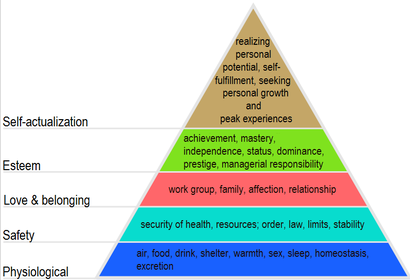
Illustration 3: Maslow's Hierarchy of Needs
Source : Content Theories of Motivation. 2017
Herzberg Theory : This theory was proposed by psychologist Frederick Herzberg. It is also known as Two Factor Theory of Motivation. Ithelps to explain the motivation and performance of the employees working in the organization using hygiene factors and motivation factors. According to this theory, people’s job satisfaction depends basically on two factors, i.e, factors for satisfaction (motivators/satisfiers) and factors for dissatisfaction (hygiene factors/ dissatisfiers).
Herzberg's Hygiene And Motivational Factors :
- Factors for satisfaction (Motivators or Satisfiers): There are various factors which are included in these factors, such as,
- Working conditions of the employees,
- Policies and administrative practices of the organization,
- Salary and Benefits of their staff members
- Supervision of the work in the organization,
- Providing job security,
- Personal life.
- Factors for Dissatisfaction (Hygiene factors or dissatisfiers): Factors which are included in these factors, are as follows,
- Responsibility of their work,
- Achievement,
- Overall growth of the employee and organization,
- Job challenge.
A David & Co Limited organization needs to work on their management system to provide their employees a better environment to work. They should provide a hygiene factors to avoid employee's dissatisfaction in the organization, but also they must provide them factors intrinsic to their work itself for employees to be satisfied with their jobs in the organization (Alshmemri, M., Shahwan-Akl, L. and Maude, P. 2017). The job should have sufficient challenge to utilize the full ability of the employee. Employees who demonstrate increasing levels of ability should be given increasing levels of responsibility.
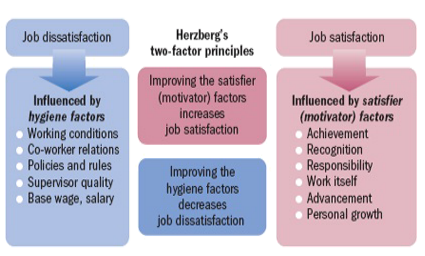
Illustration 4: Herzberg's Two Factor Theory
Source : Herzberg's Two Factor Theory. 2016
PROCESS THEORIES OF MOTIVATION
Process-based theories view motivation as a rational process. Individuals analyze their environment, develop thoughts and feelings, and react in certain ways. Process theories attempt to explain the thought processes of individuals who demonstrate motivated behavior.
- Vroom's Expectancy Theory : This theory helps to determine or explain how employees choose their options from the available actions to them. Vroom defines motivation as a process which governs the choices among alternative forms of voluntary behaviour of the employees in the organization. This theory has three factors in it, such as,
- Expectancy : This is the factor in which the employee believe that more efforts will help them in better result and success. If they work hard they will improve their work efficiency in the organization.
- Instrumentality : In this factor, employee believe that there is a connection between their activity and goal, for example, if you perform well in the organization, they will get a better reward(Types of Motivation,2016).
- Valence: In this factor, the degree to which the employee values the reward is calculated which helps them to get good results.
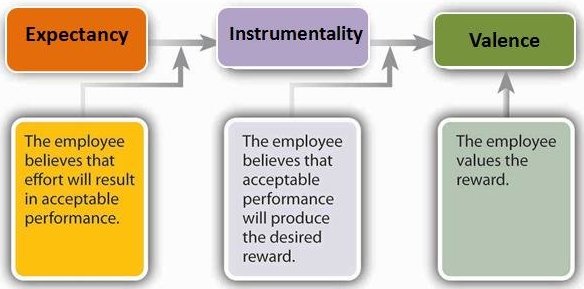
Illustration 5: Vroom's Expectancy Theory
Source : Vroom's Expectancy Theory. 2018
There are various factors which can be helpful for “A David & Co Limited” company to implement in their management system to increase the work efficiency of their employees by motivating them. Some techniques which can be used by the organization, are as follows,
- Creating a positive work environment for them to work,
- Setting goals for them to achieve,
- Recognize their achievements,
- Providing them Incentives for their work,
- They should provide professional enrichment to their employees, etc.
LO 3
P3 Explaining building of an effective team for the organization
Working in a team helps the organization to work effectively. It brings creativity in the work which help in the betterment of the organization. Teamwork also maximizes the shared knowledge in the workplace and helps to learn new skills which can be used by the organization to implement. It also teaches conflict resolution skills to their employees. There are various models which helps to build an effective team for the organization, for example,
- Tuckman's Team Development Model: It was first proposed by Bruce Tuckman. He suggested some phases which are most important in build an effective team. These phases are as follows,
- Forming Stage: In this stage, the team members meets and learns about their opportunities and challenges in the organization. They should be positive and polite in order to achieve their goals or objective. Team members are usually on their best behavior but very focused on themselves. Members attempt to become oriented to the tasks as well as to one another.
- Storming Stage: In this stage, the team members starts to build trust for each other and sort themselves. In this, employees push their limits to work. When the group members start to work together, they started to learn about individual working styles and pattern. Disagreements and personality clashes arising in the team should be resolved before the team can progress out of this stage (Natvig, D. and Stark, N.L.2016).
- Norming Stage: In this stage, employees starts to resolve their differences with other members. They start to appreciate their colleague's working style and respect others work. It helps them to socialize with others. They start to develop a stronger commitment to the team goal, and starts to see good progress for the organization.
- Performing Stage: This is the final stage of this model where the team members are more competent, autonomous and are able to handle the decision-making process without the guidance of their leaders. The team will make most of the necessary decisions by themselves only which can be a good thing for the organization.
- Adjourning Stage: This stage involves the completing of the task given to their employees. It also helps them to allow flexibility in their team roles. It also assists in the timing and selection of new members for the team which enables to create future leadership opportunities for the organization.
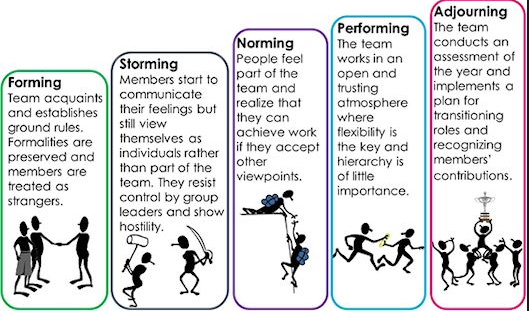
Illustration 6: Tuckman's Team Development Model
Source : Team Building and the Tuckman Model. 2014
For “A David & Co Limited” company, this model can be beneficial for them to implement, as there are members who are working as a team in the organization will get benefit from this model to understand their team members. It will help them to understand their co workers more.
LO 4
P4 Concepts and Philosophies of Organizational Behaviour
Organizational Behaviour (OB), is a concept which revolve around the nature of people and organizations. There are some philosophical concepts in organizational behaviour. The concept of OB is mainly based on two key elements,
- Nature of the employee's, and
- Nature of the Organization's
Nature of People : It is a concept which is based on the qualities of the employees working in the organization. There are some major factors which affects the nature of the employee, for example,
- Individual Difference : Every individual working in the organization is different from each other. It is the managerial approach towards each employee individually, i.e. one-on-one approach. For example, the manager of “A David & Co Limited” organization, should not be biased towards any employee in the team. He should treat everyone equally working in the organization (Konopaske, R., Ivancevich, J.M. and Matteson, M.T. 2016).
- Perception : It is an ability of the person to observe, listen and conclude something. Every member interpret things differently according to their understandings. For example, 2 employees working in the same organization have different opinions on the working management system. This can be solved by the organization by listening to all the suggestion given from their employees.
- Motivated Behaviour : It is the behaviour of the employee which helps in the motivation from their co workers in the organization. There are usually two different types of employees working in the organization,
- Positive motivation Behaviour : These are those employees which encourages others to become motivated and perform their duties with more responsibilities.
- Negative motivation Behaviour : In this, the demotivate their co workers in the organization by saying negative things to them, for example, If you don’t complete this, you will be deprived from the office, etc (Miner, J.B.2015).
- The value of the Person : organization should value their employees who are working there in order to increase their work efficiency and giving them opportunities which can help them to develop their personalities.
- Human Dignity : Organization should treat their employees respectfully. They have to maintain their dignity in the workplace.
- A whole Person : An employee’s personal life is not detached from his working life. As a result, it can impact to decrease the concentration of the employee on their work. For this, manager of the organization should treat every employee as a whole person.
Nature of the Organization : In this factor, it helps to state the motive of the organization. It also helps to understand the opportunities which are available in the global market for us (Tanner, R. 2017). Nature of organization can be understood by various concepts, for example,
- Mutuality of Interest : Mutual understanding between employee and organization is very important to maintain. It will help them to achieve their respective objectives or goals for the organization.
- Ethics: These are the moral principles of the employees and of the organization as well. It should be followed properly in order to work in ethical way which can help them achieve their target. Organization should establishing code of ethics training reward for notable ethical behaviour of the employees working there.
- Social System: It refers to the behaviour of the organization with other firms, their customers, etc. Their behaviour is mainly influenced by the group as well as individual person. Social system are of two types,
- Formal Social System : In this system, it includes firms, different organization and people considered as formal social system (Pinder, C.C. 2014).
- Informal Social system : It includes people like, friends, which enjoy and party together.
There is a huge scope in the organizational Behaviour (OB), as it can help to govern or influence the operations of an organization.
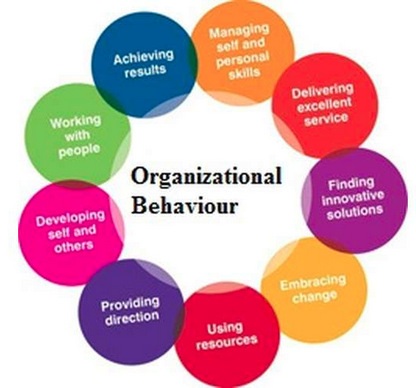
Illustration 7: Organizational Behaviour
CONCLUSION
From the above report it can be concluded that organizational behaviour is very important for “A David & Co Limited” to follow in their management system to increase their work efficiency. This will help them to evaluate the influence of culture, politics and power on the behaviour of their employees towards the organization. It also discussed about different motivational theories, such as Maslow's Hierarchy of Needs theory and Herzberg theory and Vroom's Expectancy theory which can help them to keep their employees motivated. It also demonstrated Tuckman’s Team Development model which can help them to build a strong team which can help to improve the work efficiency in the organization and the impact of development stages on individual working there.
Visit do my assignment page if you are looking for someone who can write your assignment.
REFERENCES
Books and Journals
- Alshmemri, M., Shahwan-Akl, L. and Maude, P. 2017.Herzberg’s two-factor theory. Life Science Journal. 14(5).
- D'Souza, J. and Gurin, M., 2016.The universal significance of Maslow’s concept of self-actualization. The Humanistic Psychologist. 44(2). p.210.
- Dipboye, R.L., 2016. Exploring industrial & organizational psychology: Work & organizational behavior.Browser Download This Paper.
- Gelfand, M.J. and et-al, 2017.Cross-cultural industrial organizational psychology and organizational behavior: A hundred-year journey. Journal of Applied Psychology. 102(3). p.514.
- Greenberg, J., 2014.Behavior in Organizations: Global Edition. Pearson Higher Ed.
- Konopaske, R., Ivancevich, J.M. and Matteson, M.T., 2016.Organizational behavior and management. McGraw-Hill Education.
- Luthans, F., Luthans, B.C. and Luthans, K.W., 2015.Organizational Behavior: An evidencebased approach. IAP.
- Miner, J.B., 2015.Motivation-Hygiene Theory: Frederick Herzberg. In Organizational Behavior 1.pp. 77-90. Routledge.
- Miner, J.B., 2015.Organizational behavior 1: Essential theories of motivation and leadership. Routledge.
- Miner, J.B., 2015.Organizational behavior 4: From theory to practice. Routledge.
- Natvig, D. and Stark, N.L., 2016. A Project Team Analysis Using Tuckman's Model of Small-Group Development.Journal of Nursing Education. 55(12). pp.675-681.
- Pinder, C.C., 2014.Work motivation in organizational behavior. Psychology Press.
- Tanner, R., 2017. Motivation–Applying Maslow’s Hierarchy of Needs Theory.














